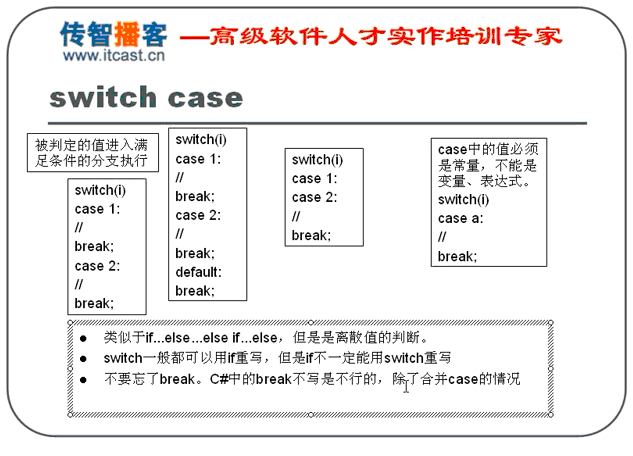c#中的switch case语句有三种结构,具体形式如下图所示:

(1)Switch的第一种结构:(如例1)
switch(i)
case 1:
//
break;
case2:
//
break;
例1
- namespace Switch
- {
- class Program
- {
- static void Main(string[] args)
- {
- int i = 2;
- switch(i)
- {
- case 2:
- Console.WriteLine("你真2!");
- Console.WriteLine("你真有才!");
- break;
- case 4:
- Console.WriteLine("你去死吧!");
- break;
- case 8:
- Console.WriteLine("发发发!");
- break;
- }
- Console.ReadKey();
- }
- }
- }
(2)Switch的第二种结构:
switch(i)
case 1:
//
break;
case2:
//
break;
default:
//
break;
例2
- namespace Switch
- {
- class Program
- {
- static void Main(string[] args)
- {
- int i = 9;
- switch(i)
- {
- case 2: //相当于if(if==2)
- Console.WriteLine("你真2!");
- Console.WriteLine("你真有才!");
- break; //C#中必须写break
- case 4:
- Console.WriteLine("你去死吧!");
- break;
- case 8:
- Console.WriteLine("发发发!");
- break;
- default: //相当于if语句的else
- Console.WriteLine("你输入的{0}没有意义",i);
- break;
- }
- Console.ReadKey();
- }
- }
- }
注意:C#中的switch语句必须写break,不写不行,但有一种情况除,合并了case情况,可以不写break。(如例3):
Switch的第三种结构:合并了case情况,以省略break.
switch(i)
case 1:
case2:
//
break;
例3:
- namespace Switch
- {
- class Program
- {
- static void Main(string[] args)
- {
- int i = 200;
- switch(i)
- {
- case 2: //相当于if(if==2)
- Console.WriteLine("你真2!");
- Console.WriteLine("你真有才!");
- break; //C#中必须写break
- case 4:
- Console.WriteLine("你去死吧!");
- break;
- case 8:
- Console.WriteLine("发发发!");
- break;
- /*
- case 100:
- Console.WriteLine("你输入的是整钱!");
- Console.WriteLine("你真有钱");
- break;
- case 200:
- Console.WriteLine("你输入的是整钱!");
- Console.WriteLine("你真有钱");
- break;
- */
- //上面的代码等同于下面的代码
- case 100:
- case 200: //相当于if(i=100||i=200),唯一一个case后不用break的情况
- Console.WriteLine("你输入的是整钱!");
- Console.WriteLine("你真有钱");
- break;
- default: //相当于if语句的else
- Console.WriteLine("你输入的{0}没有意义",i);
- break;
- }
- Console.ReadKey();
- }
- }
- }
注意:switch语句中case 的值只能是用2,4,"aaa" 等常量,不能是变量、表达式。 (如例4)
例4
- namespace Switch
- {
- class Program
- {
- static void Main(string[] args)
- {
- string s1 = Console.ReadLine();
- int i = Convert.ToInt32(s1);
- int k = 10;
- switch(k)
- {
- case i: //错误:case中值只能用2,4,"aaa" 等常量,不能写变量
- Console.WriteLine("你输入的和程序假定的一样!");
- break; //C#中必须写break
- }
- Console.ReadKey();
- }
- }
- }
总结:switch语句和if语句的区别:
● 大于等于(>=)、小于等于(<=)的判断用if语句,而等于(=)的判断用switch语句。
● switch语句中的case类似于if…else…else if…else,但是离散值的判断。
(离散值的判断自认为是等于情况的判断)。
● switch一般都可以及用if重写,但是if不一定能用switch重写(如例2)。
● 不要忘了break.C#中break不写是不行的,除了合并case的情况(如例3)。
● case 中的值必须是常量,不能是变量、表达式(如例4)。